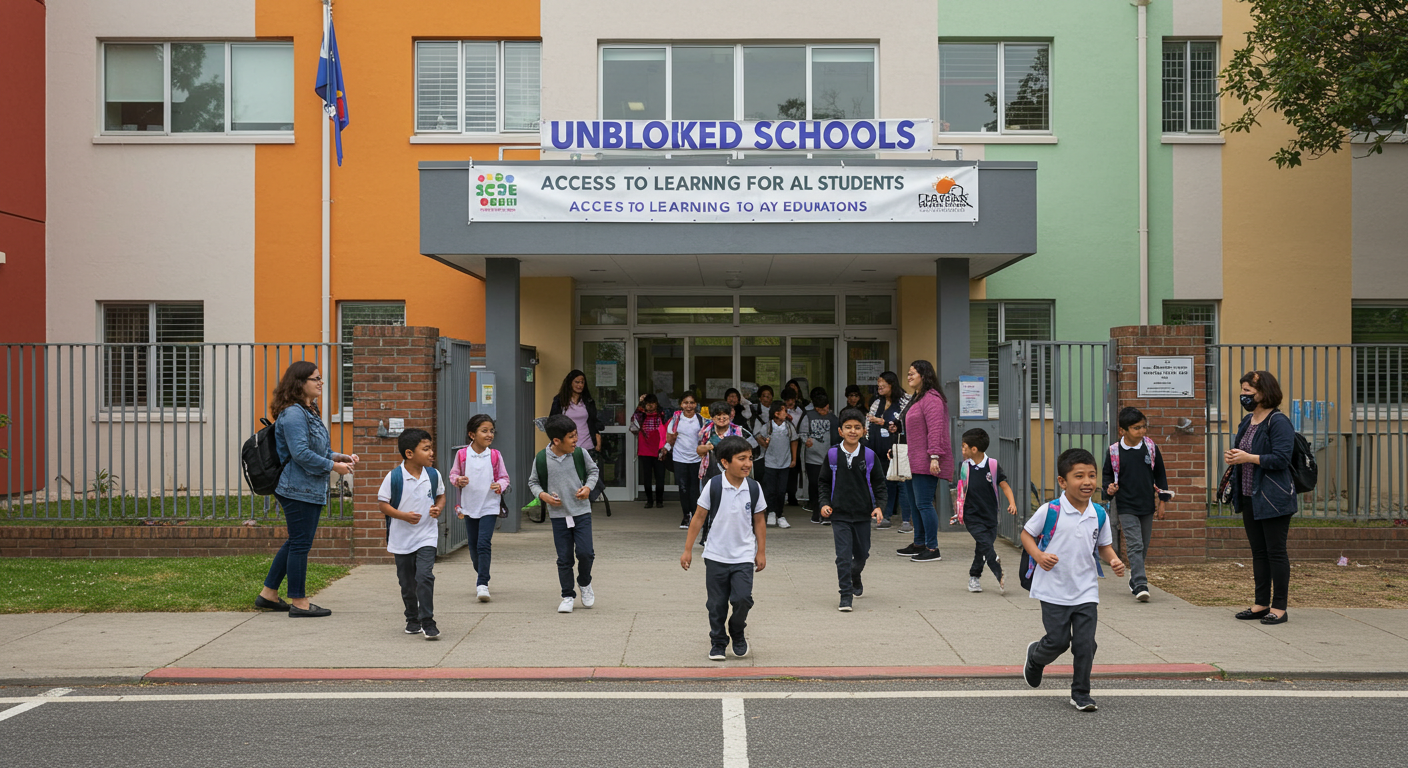Education is a powerful tool that shapes the future of individuals and societies. Yet, millions of students around the world face barriers to their education due to blocked schools. These obstacles can stem from various issues, including limited resources or systemic discrimination. Such challenges hinder learning opportunities and restrict access for countless children eager to learn.
Imagine a classroom where every student has equal access to knowledge—this vision can become a reality through unblocked schools. By addressing the reasons behind educational blockages, we can pave the way for an inclusive environment that fosters growth and success for all learners.
This blog post will explore what unblocked schools truly are, their impact on students’ lives, and how communities can advocate for change. Let’s dive into this important topic together!
What is unblocked schools?
Unblocked schools represent an educational landscape where barriers to learning are removed. They create environments that foster inclusivity and accessibility for every student.
At its core, the concept emphasizes open access to curriculum, resources, and technology. It allows learners from diverse backgrounds to thrive without hindrance.
This model encourages flexibility in teaching methods and embraces various learning styles. The focus shifts from traditional education systems that often restrict opportunities based on socioeconomic status or geographic location.
By promoting unblocked schools, we advocate for innovative approaches such as online resources and community partnerships. These efforts ensure that all students can engage with their education fully.
In essence, unblocked schools embody a commitment to equality in education—a step towards nurturing future generations empowered by knowledge.
The impact of blocked schools on students and their education
Blocked schools create significant hurdles for students. When access to education is limited, a child’s potential dims. They miss out on essential learning experiences that shape their future.
In these environments, students face isolation from resources and opportunities. Social interactions diminish, leading to feelings of loneliness and disengagement. Without the support of teachers and peers, motivation falters.
Academically, the consequences are stark. Students may struggle with foundational skills necessary for advancement. This educational gap can affect their confidence and self-esteem.
Moreover, blocked schools disproportionately impact marginalized communities. Inequities in education deepen social divides and perpetuate cycles of poverty.
Navigating this landscape becomes an uphill battle for many families. Parents often feel powerless as they advocate for their children’s rights to learn freely without barriers or discrimination.
Reasons behind blocked schools, such as lack of resources or discrimination
Blocked schools often stem from various systemic issues. A primary reason is the lack of resources. Many institutions struggle to provide basic educational materials, trained staff, and adequate facilities. This deficiency can lead to an ineffective learning environment.
Discrimination plays a significant role as well. Certain groups may face barriers based on ethnicity, socioeconomic status, or disabilities. This unjust treatment restricts access to quality education for countless students.
In some regions, political instability further complicates matters. Schools may be neglected in favor of other priorities when governments are unstable or corrupt.
Community support also varies widely. Some localities rally behind their schools while others remain indifferent, leaving vulnerable students without advocates who can push for change.
These interconnected issues create a cycle that blocks educational opportunities and limits futures for many young learners seeking knowledge and growth.
Case studies of successful unblocking efforts in different countries
In Sweden, the “Open School Initiative” stands out as a beacon of hope. This program dismantled barriers by fostering collaboration between local governments and educators. By sharing resources and creating inclusive curricula, schools transformed into accessible environments for all students.
Across the globe in Brazil, community-driven efforts have made significant strides. Parents and local activists united to push for policy changes that promote equitable access to education. Their tireless work resulted in increased funding for underprivileged schools.
Meanwhile, Canada has adopted innovative technology solutions to tackle blocked school issues. Virtual classrooms bridge gaps caused by geographical or socioeconomic barriers, ensuring every child can participate in quality learning regardless of their location.
These examples illustrate how determined communities can successfully advocate for unblocked schools, paving the way for healthier educational landscapes worldwide. Each initiative reflects a unique approach tailored to specific challenges faced within different countries.
Benefits of unblocked schools for students, teachers, and communities
Unblocked schools create an environment where creativity flourishes. Students gain access to a wealth of resources, enhancing their learning experience. With diverse materials at their fingertips, they can explore subjects deeply and engage with various perspectives.
Teachers benefit greatly from unblocked schools too. They can implement innovative teaching methods without the constant worry about restrictions. This freedom fosters professional growth and collaboration among educators, leading to improved lesson plans and student engagement.
Communities also thrive in this atmosphere of open education. A well-educated populace often results in reduced crime rates and increased civic participation. When students succeed academically, they contribute positively to society as informed citizens.
Additionally, unblocked schools pave the way for inclusivity. By removing barriers based on socioeconomic status or discrimination, every child has the chance to shine irrespective of their background or circumstances.
Strategies for advocating for unblocked schools in your community
Advocating for unblocked schools begins with awareness. Start by educating yourself and those around you about the issues at hand. Host community discussions, workshops, or informational sessions to shed light on how blocked access affects students.
Form partnerships with local organizations that share your vision. Collaborate with nonprofits focused on education reform to amplify your voice and reach a broader audience.
Leverage social media platforms to spread the message widely. Share stories, statistics, and calls-to-action that resonate emotionally while providing concrete solutions.
Encourage parents and teachers to join in on advocacy efforts. Their firsthand experiences can significantly impact decision-makers when addressing school barriers.
Engage directly with policymakers. Arrange meetings where advocates present clear demands backed by research-driven data showcasing the benefits of unblocked schools for all students in the community.
The importance of equal access to education for all students and the steps we can take to achieve it
Equal access to education is vital for fostering a fair and just society. Every student, regardless of background or circumstance, deserves the opportunity to learn and thrive in an inclusive environment.
Barriers such as socioeconomic status, geographic location, and discrimination must be addressed. These obstacles can hinder potential and limit future opportunities for countless individuals.
Community engagement plays a crucial role in advocating for unblocked schools. By raising awareness about educational disparities, we can mobilize support from local organizations and stakeholders.
Empowering parents through information can also spark change. When families understand their rights within the education system, they become strong advocates for their children’s needs.
Investing in resources like technology and training helps create equitable learning environments. Schools that embrace diversity foster innovation while preparing students to navigate a complex world together.
Small steps can lead to significant transformations when communities unite behind equal access to education.
Conclusion
Access to education is a fundamental right. Unblocked schools create pathways for every student, ensuring that they can learn without barriers. The positive impact of these initiatives extends beyond individual students; it enriches communities as well.
When we advocate for unblocked schools, we champion equity and justice in education. By addressing the root causes of blocked schools—whether it’s resource shortages or systemic discrimination—we can foster an environment where all students thrive.
It’s crucial to continue pushing for equal access and to support efforts that promote inclusive learning environments. Every step taken towards unblocking schools benefits not only students but also teachers, families, and entire communities.
By working together, sharing success stories from around the globe, and implementing grassroots strategies in our local areas, we can make significant strides toward educational equality. Let’s commit to this cause so no child is left behind in their pursuit of knowledge.

